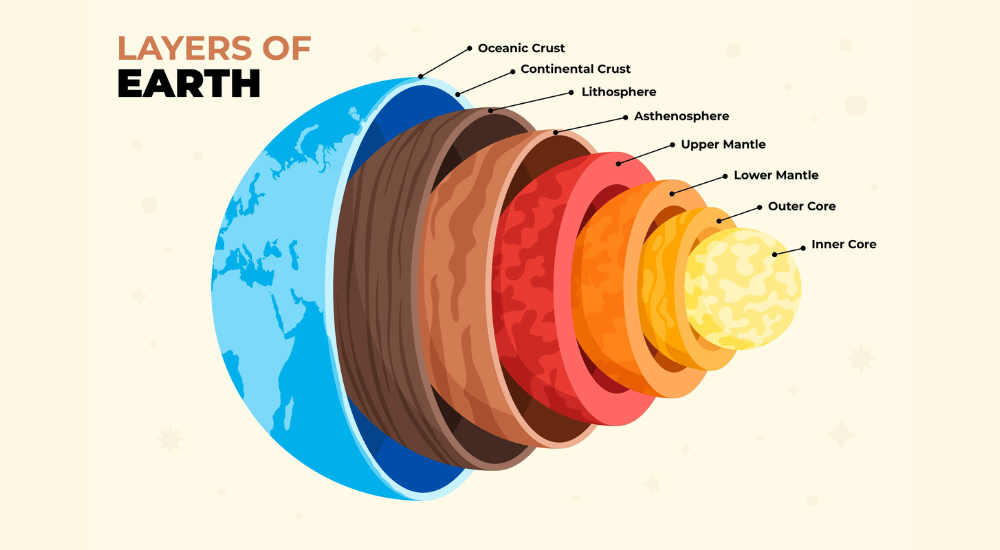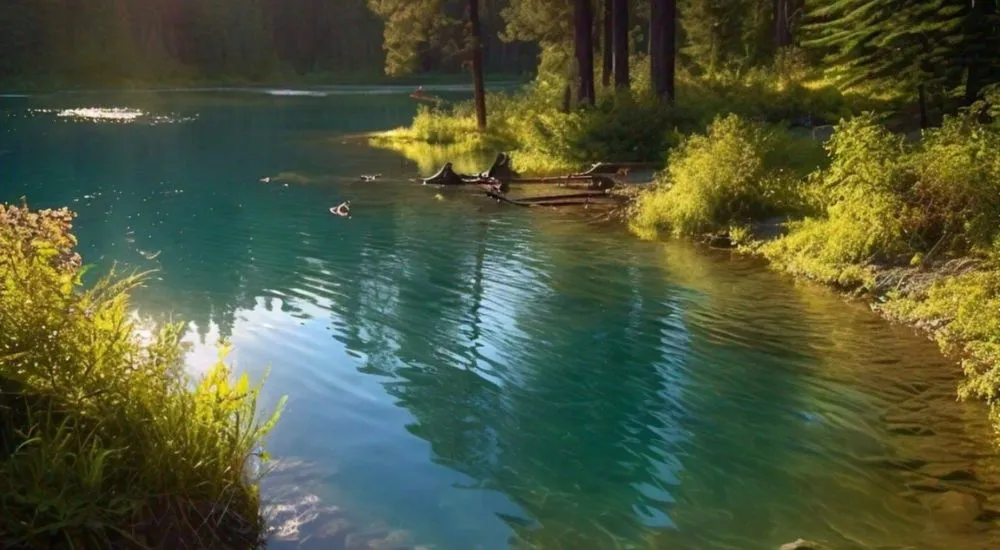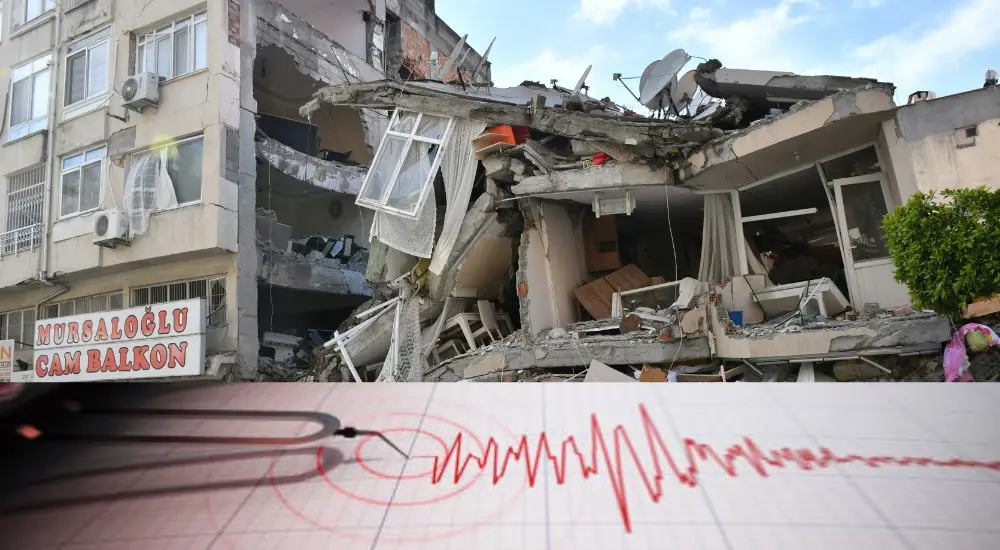The internal structure of the Earth is a fascinating topic that unveils the secrets hidden beneath our feet. Comprising four layers, the Earth’s structure consists of the solid outermost crust, followed by the semi-fluid upper mantle, the liquid outer core, and the solid inner core. Each layer plays a vital role in shaping our planet’s dynamics, from generating magnetic fields to driving plate tectonics. Scientists use seismic waves and other geophysical techniques to study these layers, gaining insights into Earth’s evolution and geologic processes. Understanding the internal structure of the earth is crucial for comprehending natural phenomena like earthquakes and volcanic activities.
Some important multiple-choice questions related to this topic are listed below. Try to answer these questions after reading enough in this topic. Also tie your answer with the given one. This practice may help you sharpen your preparation for any competitive exam along with increase your knowledge in this topic.
1. Which layer of the Earth is primarily composed of solid iron and nickel?
(A) Crust
(B) Mantle
(C) Outer core
(D) Inner core
(D) Inner core
Explanation: The inner core is the innermost layer of the Earth, and it is primarily composed of solid iron and nickel. It is under immense pressure, which keeps it in a solid state despite the high temperatures.
2. The lithosphere is composed of which two layers?
(A) Crust and upper mantle
(B) Outer core and inner core
(C) Mantle and lower mantle
(D) Crust and lower mantle
(A) Crust and upper mantle
Explanation: The lithosphere is the rigid outer layer of the Earth and is composed of two layers: the crust and the uppermost part of the mantle. These layers together form the solid, brittle outer shell of the Earth.
3. Which layer of the Earth is responsible for generating Earth’s magnetic field?
(A) Crust
(B) Mantle
(C) Outer core
(D) Inner core
(C) Outer core
Explanation: The Earth’s magnetic field is generated by the movement of molten iron and nickel in the outer core. This movement, driven by convection currents, creates electric currents that produce the magnetic field.
4. The asthenosphere is a part of which layer of the Earth?
(A) Crust
(B) Mantle
(C) Outer core
(D) Inner core
(B) Mantle
Explanation: The asthenosphere is a partially molten and ductile region located in the upper mantle. It is a relatively soft and weak layer that allows the lithospheric plates to move and slide over it.
5. Which type of seismic wave can travel through both solids and liquids?
(A) P-waves
(B) S-waves
(C) Surface waves
(D) Love waves
(A) P-waves
Explanation: P-waves (primary waves) are the fastest seismic waves and can travel through both solids and liquids. They cause particles to move in the same direction as the wave propagation, leading to compressions and rarefactions.
6. The Moho discontinuity marks the boundary between which two layers of the Earth?
(A) Crust and upper mantle
(B) Outer core and inner core
(C) Mantle and lower mantle
(D) Crust and lower mantle
(A) Crust and upper mantle
Explanation: The Moho discontinuity, also known as the Mohorovičić discontinuity, is the boundary between the Earth’s crust and the underlying uppermost part of the mantle. It represents a significant change in composition and density.
7. The density of the Earth generally increases with depth. What is the primary reason for this increase?
(A) Decrease in temperature
(B) Increase in pressure
(C) Changes in chemical composition
(D) Expansion of rock materials
(B) Increase in pressure
Explanation: The primary reason for the increase in density with depth in the Earth is the increase in pressure. As you go deeper into the Earth, the weight of the overlying layers causes an increase in pressure, leading to denser materials.
8. Which layer of the Earth is the thickest?
(A) Crust
(B) Mantle
(C) Outer core
(D) Inner core
(B) Mantle
Explanation: The mantle is the thickest layer of the Earth, extending from the base of the crust to the outer core. It accounts for about 84% of the Earth’s volume and is primarily composed of solid rock materials.
9. The transition zone is a region located between which two layers of the Earth?
(A) Crust and upper mantle
(B) Outer core and inner core
(C) Upper mantle and lower mantle
(D) Crust and lower mantle
(C) Upper mantle and lower mantle
Explanation: The transition zone is a region located between the upper mantle and the lower mantle. It is characterized by changes in mineralogy and physical properties due to increasing pressure and temperature with depth.
10. The Earth’s outermost layer is made up of:
(A) Solid rock
(B) Molten lava
(C) Loose soil and sediments
(D) All of the above
(D) All of the above
Explanation: The Earth’s outermost layer, known as the crust, can be composed of different materials depending on the location. It can consist of solid rock, molten lava (in volcanic regions), as well as loose soil and sediments (in areas such as beaches or riverbeds).
11. Which layer of the Earth is characterized by convection currents that drive plate tectonics?
(A) Crust
(B) Mantle
(C) Outer core
(D) Inner core
(B) Mantle
Explanation: The mantle is the layer of the Earth located between the crust and the core. It is composed of solid rock material that undergoes convection currents due to the heat generated by radioactive decay. These convection currents drive the movement of tectonic plates on the Earth’s surface.
12. Which type of seismic wave is responsible for causing the most destruction during an earthquake?
(A) P-waves
(B) S-waves
(C) Surface waves
(D) Love waves
(C) Surface waves
Explanation: Surface waves are seismic waves that travel along the Earth’s surface. They cause the most destruction during an earthquake as they produce rolling and shaking motions, which can damage buildings and infrastructure.
13. The Gutenberg discontinuity marks the boundary between which two layers of the Earth?
(A) Crust and upper mantle
(B) Outer core and inner core
(C) Mantle and lower mantle
(D) Upper mantle and lower mantle
(B) Outer core and inner core
Explanation: The Gutenberg discontinuity is the boundary between the outer core and the inner core of the Earth. It is characterized by a significant increase in seismic wave velocities, indicating a change in composition and physical properties.
14. Which layer of the Earth is composed mainly of silicate minerals rich in iron and magnesium?
(A) Crust
(B) Mantle
(C) Outer core
(D) Inner core
(B) Mantle
Explanation: The mantle is primarily composed of silicate minerals rich in iron and magnesium, such as olivine and pyroxene. These minerals contribute to the mantle’s density and solid-state behaviour.
15. The Mohorovičić discontinuity is named after a scientist from which country?
(A) United States
(B) Russia
(C) Croatia
(D) France
(C) Croatia
Explanation: The Mohorovičić discontinuity, also known as the Moho, is named after Andrija Mohorovičić, a Croatian seismologist who first identified and studied this boundary between the crust and the mantle.















